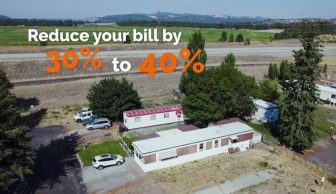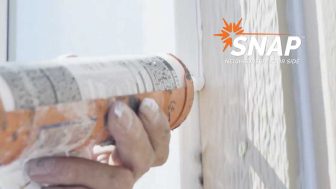Posted by April Myers on Wednesday, June 28 th , 2023
Washington ROC Members reaped rewards of neighborhood-wide effort
MEAD, Wash. – When an organized ROC with strong leadership collaborates with a local nonprofit and utility company working to help communities have safer and stronger homes, magic really can happen.
In the last two years, Spokane Neighborhood Action Partners (SNAP) with funding from Spokane, Wash.-based Avista Utilities, weatherized more than 100 homes in Takesa Village Homeowners Cooperative, lowering utility costs for homeowners and creating safer, more sustainable homes, said Tina McKinstry, Board President at Takesa Village.
Takesa Village sits on Washington’s eastern border, about 30 minutes from Spokane. The climate there takes a toll on homes – the co-op sees baking hot temperatures in the summer.
“My bill has dropped consistently month after month.” -Tina McKinstry
“And in the winter, we have lots of snow and lots of freezing temps,” McKinstry said. “One of our biggest problems is freezing pipes, but when they insulate the home, the house is way warmer. They replaced 90 percent of my windows, which cut way back on my power bill. My bill has dropped consistently month after month. It’s about 20 to 30 percent less than this time last year.”
Weatherization is the process of improving the energy efficiency of homes by treating the home, said Kirby Weythman, Inspection Services Supervisor for SNAP.
“Even in new construction, when you build a house, each trade builds it as a separate house, so there tends to be a lot of outside air that gets in,” Weythman said. “We improve the insulation, repair leaks and drastically improve the comfort and energy usage. The first thing in any energy journey is determining your priorities.”
It takes about three to four days to weatherize a manufactured home and costs about $20,000 per home, Weythman said. Avista Utilities paid for the weatherization of each home, which allowed SNAP to also replace windows in some homes.

-
Save
SNAP provides people of low income with access to needed resources. For the weatherization leg of its mission, SNAP receives a portion of its funding from the federal Low Income Home Energy Assistance Program (LIHEAP), which assists eligible low-income households with their heating and cooling energy costs, bill payment assistance, energy crisis assistance, energy-related home repairs and weatherization.
The typical application process for LIHEAP is lengthy for homeowners. But Takesa Village was able to participate in the program as an entire community, which expedited the process.
“Doing it as a community seems to be successful, and Takesa, because it is a ROC, had a unique ability to rally the community,” said Weythman. “We had a point of contact with Tina and even though we went door-to-door with each homeowner, if we couldn’t get in touch with someone, Tina helped us coordinate a day to bring everyone together. That’s the strength of having someone like Tina in a leadership position.”
If you’re interested in weatherization, visit LIHEAP and for more about SNAP Weatherization and Takesa Village Cooperative, watch this video.
While weatherizing a home can be pricey, there are a few quick and cheap fixes that Weythman recommends:
- Check your air filter. Hold it up to the light and if you can’t see through it, it’s time to change it. This fix costs as little as $5 and can help with air flow in your home.
- Check on water leaks. Do you have any dripping faucets? A simple kitchen faucet drip can use up to 15,000 gallons per year. If it’s a hot water drip, there are energy losses too. Sometimes, the fix is as simple as replacing a washer and homeowners can do that themselves.

-
Save
-
- Check and make sure that your registers are not covered by furniture. If they are, move the furniture to make sure all the air is flowing at an optimal level. “An unbalanced HVAC system will always make it less efficient,” Weythman said.
- Most of the energy leakage in manufactured homes comes from the “bellies” or underfloor of the home. Weythman said that’s the case about 30 percent of the time. Check underneath your home and make sure the belly has not been cut through. If there are issues, insulation may need to be added or it might need to be repaired.
- If you’re reroofing your home, choose lighter colors materials, which will better reflect UV rays. Dark colors can absorb much of the heat.
- Invest in a programmable thermostat that could save you 10 percent on your heating bill.
- Research participating in community solar programs like Lakeville Village, Inc., in Geneseo, N.Y. Community solar panels are a great way for manufactured home communities to generate green energy.
- Consider an Energy Audit. These audits typically cost about $500 but are only useful to invest in if you are planning on putting more money into weatherizing your home. Click here or here to find a reputable Energy Auditor. There also may be rebates/tax credits available through the Inflation Reduction Act.
- Check your master bedroom and master bathroom especially if you have a large corner tub. That’s often an area of air loss.
- Look at swapping your gas water heater for a more efficient electric one or a heat pump water heater, which can save homeowners between $400 and $500 per year in energy costs.
- Foam or caulk around windows if you notice air flow in the cracks.
